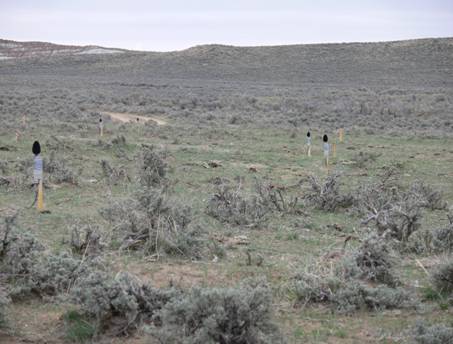Populations of the greater sage-grouse (Centrocercus urophasianus) are declining throughout their range, leading to their designation as a Species of Concern and their recent consideration for listing under the Endangered Species Act. Many factors have been implicated in this decline (e.g. grazing, habitat loss) and there appears to be no universal cause across the range of the species. It is likely that a suite of interacting factors is contributing to the decline, which complicates conservation efforts. Over the last decade, natural gas development has expanded rapidly across much of the sage-grouse habitat. It is crucial to determine whether this activity is contributing to observed declines in sage-grouse populations. Since we are still in the relatively early stages of this energy exploration, steps can be taken to mitigate the impact of these activities if the problem is diagnosed early. Determining whether natural gas development impacts sage-grouse is critical to the goal of providing sound environmental protections in areas of energy development, therefore ensuring that it will not again be necessary to consider listing sage-grouse under the Endangered Species Act.
One potential means by which energy development might impact sage-grouse populations is through the production of noise. Acoustic communication is known to be important in the reproductive behaviors of sage-grouse, and energy exploration and development activities generate substantial noise; it is therefore important to determine whether noise produced from energy development affects sage-grouse breeding biology. Sage-grouse mate during the early spring (March-April). During this mating season, males aggregate on display sites called “leks” where females visit to observe male display behaviors and choose their mates. There is evidence that the acoustic displays produced by males on leks facilitate reproduction in at least two ways. First, females use these vocalizations to find leks within the habitat. Second, after arrival at a lek, there is evidence that females use male vocalizations (and other aspects of male display) to choose a mate. Anthropogenic noise in the sage grouse habitat may mask vocalizations produced by males, interfering both with females’ ability to locate leks and to choose mates.
Results
The broad goal of this project is to provide scientific evidence of any impact of noise from energy development on greater sage-grouse; this evidence can be used inform wildlife management and energy-development policies. If our results suggest that noise has a negative impact on grouse, this will suggest solutions (e.g. noise mitigation) that may help grouse and energy development to co-exist. If our results suggest that noise does not impact grouse, this will help to focus research and conservation resources onto other solutions that might be more fruitful in reducing the decline in sage-grouse populations.
Benefits
Benefits of project will be to gather information on strutting, mating and nesting of sage grouse in order to make a better decision on the necessary setback margins when permitting oil and gas exploration and production activities. This will assist in the timing of activities when in close proximity of leks.
Summary
Descriptive Acoustics
Ten autonomous recording units (ARUs) were built using off-the-shelf technology. A personal digital assistant (PDA), a small programmable computer, forms the basis of each ARU.
A stereo pre-amplifier and analog-to-digital converter and digital audio interface from Core Audio and two Sennheiser microphones comprise the audio equipment for each ARU. Audio data is stored on Compact Flash media. Custom software provides a means of taking audio samples at preset times for specified durations.
Gas field noise primarily on the Anticline Project Area in Sublette County near Pinedale WY was measured using ten autonomous recording units (ARUs). We measured noise at 5-20 minute intervals throughout the day; we sampled noise at between 2 to 12 locations (2 microphones per ARU) at each site. We also took noise measurements (Larson-Davis 824 Sound Level Meter) and GPS readings (Meridian Gold) circling each site and along line transects radiating from the source. We measured sound at two drilling sites, two large compressor stations, and on three roads.
Transects were done to characterize vegetation cover. These were used for modeling of sound propagation (objective 3 of the overall project).
Experimental
In spring 2006, we began an experiment to test the hypothesis that noise from energy development affects sage grouse reproductive behavior. To do so, we played back recorded noise to 4 leks and monitored another 4 leks as controls. We placed leks in groups to balance for size and location, and then randomly assigned them to noise or control groups.
We monitored the leks daily; making multiple counts of male and female attendance during the lekking period, videotaping behaviors and photographing a sample of birds for individual identification. Four people monitored leks, with each person visiting two leks each day. The leks were divided into 25m sections with small survey stakes on the lek edge. The sections provided a way to look at spatial distribution of birds on the lek. Multiple counts were made each day by section of each lek. The first lek visited each day was videotaped using HD 1080i format which has about 4 times the resolution of SVHS video. We are currently beginning the analysis of these videotapes at UC Davis for display rates, chases, fights and position of birds. Photographs of the tail feathers of individual birds were taken at the second lek visited each day and labeled by date, time, lek and section of the lek. The pattern of white on the tails of male sage grouse are unique within a given season and can be used for identification of individuals without the disturbance of trapping and marking birds. Photographs will be analyzed at UC Davis for identification of individuals and patterns of individual location on the leks. The order of visiting the leks was swapped each day so a lek was videotaped every other day and photographed on alternate days.





